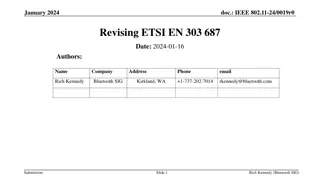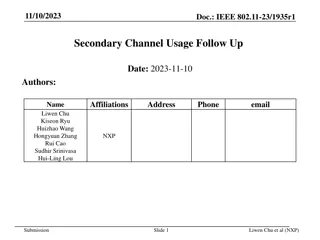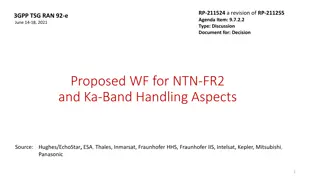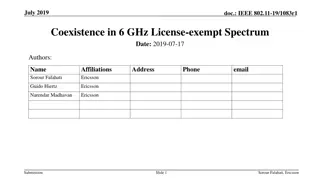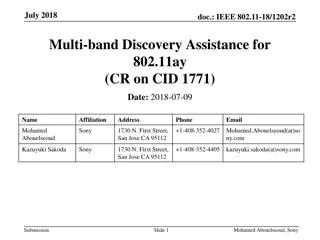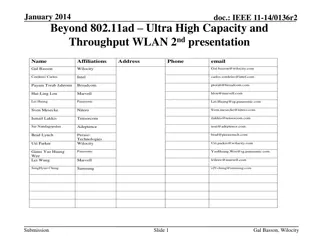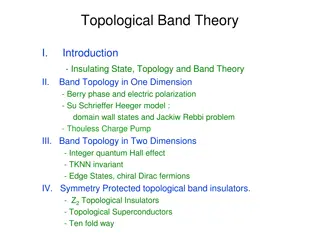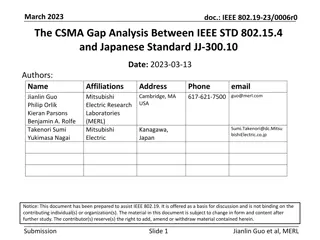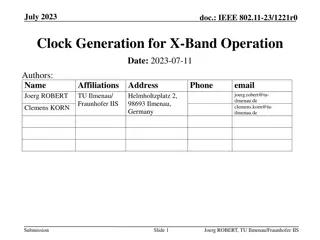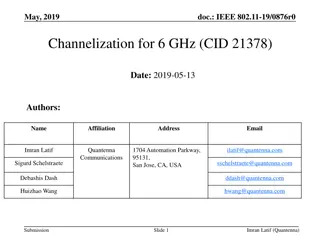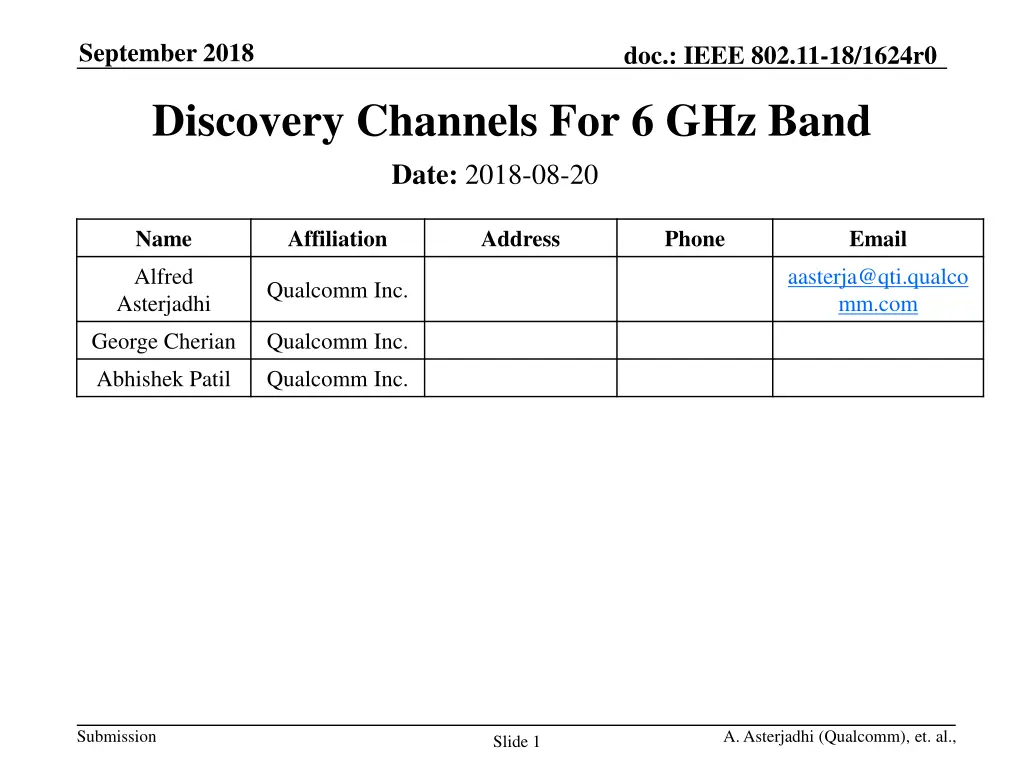
IEEE 802.11-18/1624r0 - 6 GHz Band Discovery Channels Overview
Dive into the details of IEEE 802.11-18/1624r0 document discussing the introduction, problem statement, proposed solutions, and the significance of Discovery Channels for the 6 GHz band. Explore topics such as reducing scanning latency, improving system efficiency, and defining channelization for discovery purposes.
Download Presentation

Please find below an Image/Link to download the presentation.
The content on the website is provided AS IS for your information and personal use only. It may not be sold, licensed, or shared on other websites without obtaining consent from the author. If you encounter any issues during the download, it is possible that the publisher has removed the file from their server.
You are allowed to download the files provided on this website for personal or commercial use, subject to the condition that they are used lawfully. All files are the property of their respective owners.
The content on the website is provided AS IS for your information and personal use only. It may not be sold, licensed, or shared on other websites without obtaining consent from the author.
E N D
Presentation Transcript
September 2018 doc.: IEEE 802.11-18/1624r0 Discovery Channels For 6 GHz Band Date: 2018-08-20 Name Affiliation Address Phone Email Alfred Asterjadhi aasterja@qti.qualco mm.com Qualcomm Inc. George Cherian Qualcomm Inc. Abhishek Patil Qualcomm Inc. Submission A. Asterjadhi (Qualcomm), et. al., Slide 1
September 2018 doc.: IEEE 802.11-18/1624r0 Introduction TGax PAR has opened the 6 GHz band to be used by 11ax STAs Regulatory discussions for access rules, and restrictions are still ongoing Discovery/scanning were discussed in [1] under these assumptions Dual Radio AP (2.4/5GHz plus 6 GHz) Anchored in 2.4/5 GHz band to perform discovery/scanning functions Allows discovery/scanning/roaming in 6 GHz only under certain conditions Non-AP STA discovers 6 GHz APs in the 2.4/5 GHz bands and optionally Passively scan the 6 GHz bands for the presence of APs Actively scan if the STA already knows the AP that it is probing In this presentation we discuss the following Enable discovery of 6 GHz-only APs (infrastructure and soft APs) Limit channel pollution due to scanning in the 6 GHz band Reduce scanning latency for 6 GHz operations Submission Slide 2 A. Asterjadhi (Qualcomm), et. al.,
September 2018 doc.: IEEE 802.11-18/1624r0 Problem Statement Up to 1280 MHz of spectrum are expected to be available in 6 GHz Which can be split in to up to 64 channels of 20 MHz each, Each of these channels are greenfield (i.e., no incumbent dot11 devices) Without defining any rules all 64 channels need to be scanned Increases scanning latency for non-AP STA scanning for 6 GHz APs Total scan time of up to 1.2 s (if MinChannelTime=20 ms (more in other cases)) Leads to increased power consumption, and increased connectivity outage Impacts systems performance of those STAs already operating in these channels Due to probe storming effect, reduced access opportunities, increased collisions, etc. Affecting especially certain applications with stringed QoS requirements Augmented reality (AR)/virtual reality (VR), real-time voice, video, gaming, etc. Submission Slide 3 A. Asterjadhi (Qualcomm), et. al.,
September 2018 doc.: IEEE 802.11-18/1624r0 Proposed Solution Define 6 GHz channelization for discovery purposes Reducing scanning times and improving its efficiency For passive, active scanning, and roaming Improve system s efficiency of 6 GHz compared to 2.4/5 GHz Allocate a subset of channels as discovery channels Option 1: Subset located in a contiguous portion of 6 GHz band E.g., scanning concentrated only in the lower portion of the band Option 2: Subset consists of equally spaced 20 MHz channels E.g., scanning concentrated in channels 1, 5, , 13, etc. We describe this option in more detail in subsequent slides Similar to what has been proposed in [2] for 11ba Submission Slide 4 A. Asterjadhi (Qualcomm), et. al.,
September 2018 doc.: IEEE 802.11-18/1624r0 Discovery Channels (DC) DCs are equally spaced with locations defined in the standard DC spacing is of nonunitary periodicity (e.g., every 4, 8, 16, , channels) The higher the DC periodicity the better since Scanning latency reduces with reduced number of DC channels System efficiency increases with increased number of non-DC channels A DC periodicity requires AP to satisfy any of the following Operating with enough BW to cover one DC E.g., 80 MHz for 4C, 160 MHz for 8C, 320 MHz for 16C Delegating its advertisement to neighboring APs that cover a DC E.g., using Neighbor Report IEs with AP s information Submission Slide 5 A. Asterjadhi (Qualcomm), et. al.,
September 2018 doc.: IEEE 802.11-18/1624r0 DC Periodicity: Evaluation Definitions: SYS Ratio Percentage of channels where no scanning activity exists Max Scan Time Maximum scanning time to detect AP in the 6 GHz band MinChanTime is equal to 20 ms DC periodicity 1 channel (base) # of DCs 64 Max Scan Time 1280 ms SYS Ratio 0 % 4 channels 8 channels 16 8 320 ms 160 ms 75 % 87.5 % 16 channels 4 80 ms 93.5 % 32 channels 2 40 ms 98.3 % Recommend the definition of DCs with 8-C periodicity Good SYS ratio, and sufficient number of DC channels Reduced scanning latency, and one DC can easily be covered in a 160 MHz BSS Submission Slide 6 A. Asterjadhi (Qualcomm), et. al.,
September 2018 doc.: IEEE 802.11-18/1624r0 HE BSS Setup with 8-C DCs CH13 CH16 CH17 CH9 CH9 CH10 CH10 CH11 CH11 CH12 CH12 CH14 CH14 CH15 CH15 DC DC DC SYS SYS SYS SYS SYS SYS SYS AP 1 AP 2 AP 3 AP 1 sets up 160 MHz BSS (at least one DC will fall in BSS BW) Select BSS s primary channel to coincide with the discovery channel Preferred option for HE BSS due to its simplicity, and minimal spec changes BSSs with independence of PC and DC can be considered as part of EHT AP 2 and AP 3 set up 80 MHz BSS (i.e., with narrower BW) Possible e.g., when including DC (AP1) or delegating neighbor AP (AP3) Submission Slide 7 A. Asterjadhi (Qualcomm), et. al.,
September 2018 doc.: IEEE 802.11-18/1624r0 Scanning in Discovery Channels Scanning is same as baseline except that Scanning (active and passive) limited to discovery channels (DC) only Fast Passive scanning (inherit .11ai functionalities) FILS Discovery frames should be generated at least every MinChanTime Active scanning (inherit .11ai functionalities) STAs wait for at least MinChanTime before sending Probe Request frame FD frame indicates whether AP allows EDCA-based pre-association frames May include power control and other information in carried elements If nothing is detected then move to next DC or send directed Probe Request Submission Slide 8 A. Asterjadhi (Qualcomm), et. al.,
September 2018 doc.: IEEE 802.11-18/1624r0 Conclusion We discussed discovery channels for 6 GHz band that Reduce scanning latency Improve scanning efficiency Increase systems performance Compared to baseline all-channel scanning access Submission Slide 9 A. Asterjadhi (Qualcomm), et. al.,
September 2018 doc.: IEEE 802.11-18/1624r0 Spec text A 6G STA may perform active and passive scanning and send pre-association frames only in discovery channels, which are indexed as c = (n-1)*8, where n varies between 1 to 8. The STA shall not send pre-association frames in channels that are not discovery channels. Submission Slide 10 A. Asterjadhi (Qualcomm), et. al.,
September 2018 doc.: IEEE 802.11-18/1624r0 References [1] G. Cherian (Qualcomm Inc.) et. al., 11-18/1256r0 11ax operation in 6 GHz [2] G. Li (Apple) et. al., 11-17/1608/r7 WUR discovery-frame for smart scanning Submission Slide 11 A. Asterjadhi (Qualcomm), et. al.,



